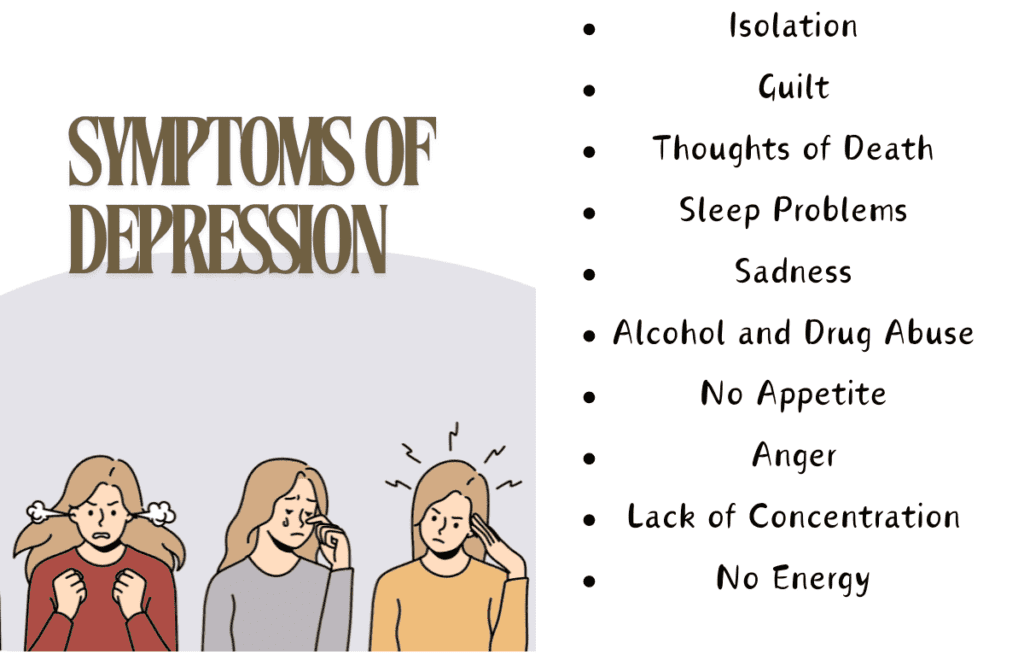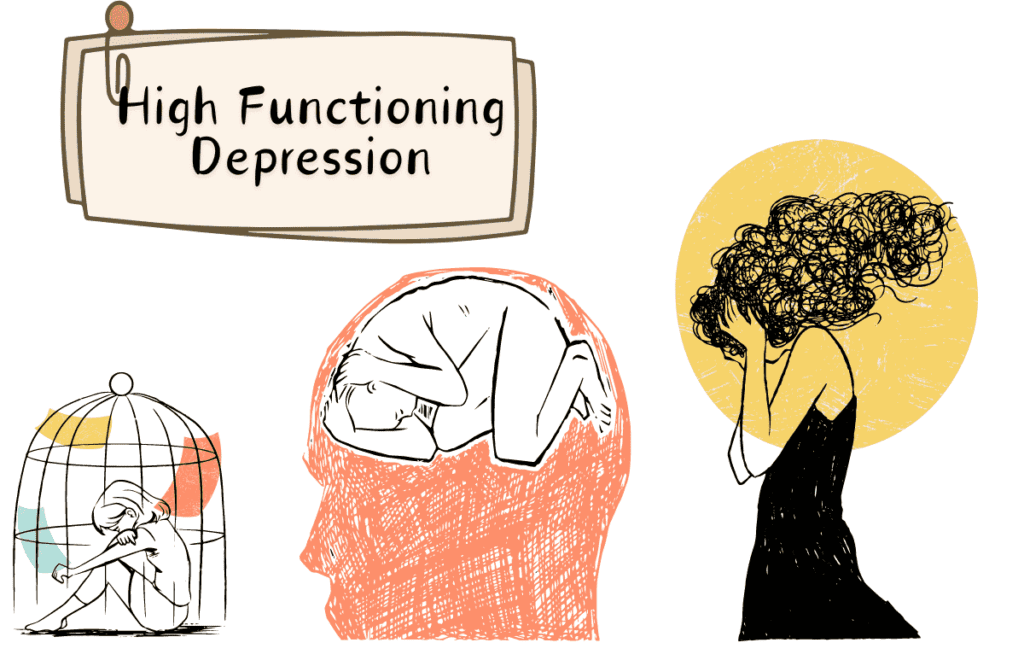What is high-functioning depression?
It’s a lesser-known type of depression where individuals experience ongoing symptoms, yet manage to keep up with daily life.
Despite appearing functional, these individuals often struggle with anxiety, persistent sadness, low energy, and other challenging symptoms like Diarrhea
According to the World Health Organization Globally, more than 264 million people of all ages face depression, highlighting the widespread impact of this issue. In this article, we’ll explore what high-functioning depression looks like, its symptoms, and why seeking help is crucial.
High-functioning depression, sometimes referred to as persistent depressive disorder or dysthymia, is a subtype of depression characterized by its insidious nature and the ability of individuals to maintain a façade of normal functioning despite experiencing depressive symptoms. Here’s an exploration of its definition, characteristics, and how it differs from clinical depression:
Definition and Characteristics
Persistent Depressive Symptoms: Individuals with high-functioning depression experience persistent feelings of sadness, hopelessness, and low self-esteem over an extended period.
Unlike major depressive episodes that can be intense but episodic, dysthymia is chronic and less severe but still debilitating.
Masking of Symptoms: One of the defining features is the ability to hide or minimize symptoms in social or professional settings. This can lead to a perception that the individual is coping well or even thriving, despite internal struggles.
Functional Impairment: Despite outward appearances of normalcy, those with high-functioning depression may find it challenging to derive enjoyment from activities, maintain relationships, or perform at their best academically or professionally.
Physical Symptoms: Alongside emotional symptoms, there may be physical manifestations such as fatigue, changes in appetite or sleep patterns, and a lack of energy.
How it Differs from Clinical Depression:
Severity and Duration: Clinical depression (major depressive disorder) typically involves more severe symptoms that can significantly impair daily functioning. It may also include episodes of intense sadness, loss of interest in activities, and thoughts of self-harm or suicide. In contrast, high-functioning depression is characterized by milder but persistent symptoms over a longer period.
Visibility of Symptoms: High-functioning depression often goes unnoticed or is underestimated because individuals appear functional and may actively hide their emotional struggles.
On the other hand, clinical depression may be more evident due to its more pronounced impact on daily life and behavior.
Treatment Considerations: Both types of depression can benefit from treatment, including therapy and medication. However, the approach may differ slightly based on the severity and specific symptoms presented.
High-functioning depression might require interventions that focus on building coping skills and addressing underlying emotional challenges, while clinical depression often necessitates more intensive therapeutic interventions and sometimes hospitalization for safety reasons.
Symptoms of High Functioning Depression
High-functioning depression can manifest through various emotional, behavioral, and cognitive signs, despite individuals maintaining a façade of functionality. Here are some common symptoms categorized into these three domains:

Emotional Signs
Persistent Sadness: Individuals with high-functioning depression may experience a lingering sense of sadness or emptiness, often without a specific trigger.
Hopelessness: A pervasive feeling of hopelessness about the future or a general sense of pessimism can be present.
Low Self-Esteem: Feelings of inadequacy, self-criticism, or a sense of worthlessness may persist, impacting self-esteem.
Emotional Numbness: Some individuals may feel emotionally numb or detached from their surroundings and relationships, despite appearing engaged outwardly.
Behavioral Signs
Withdrawal: Social withdrawal or a tendency to isolate oneself from others, even though they may continue to interact in social settings.
Increased Irritability: Heightened sensitivity to criticism or irritability towards minor frustrations can be noticeable.
Changes in Appetite or Sleep: Fluctuations in appetite, leading to weight loss or gain, and disturbances in sleep patterns (insomnia or excessive sleep) may occur.
Perfectionism: A heightened need for control or perfectionism in various aspects of life, which can lead to increased stress and frustration.
Cognitive Signs
Difficulty Concentrating: Problems with focus, memory lapses, or difficulty making decisions may arise, affecting productivity despite efforts to maintain functionality.
Negative Thinking Patterns: Persistent negative thoughts or a tendency to dwell on failures, setbacks, or perceived shortcomings.
Imposter Syndrome: Feeling like a fraud or doubting one’s accomplishments, despite external evidence of competence.
Ruminative Thoughts: Repetitive thoughts about past failures or regrets, which can contribute to feelings of guilt or self-blame.
Causes and Triggers
Causes:
Genetics: Family history plays a significant role in the development of depression, including high-functioning depression. Research suggests that individuals with a family history of mood disorders are more likely to experience depression themselves.
Brain Chemistry: Imbalances in neurotransmitters, particularly serotonin, dopamine, and norepinephrine, are implicated in depression. These neurotransmitters regulate mood, and their dysregulation can contribute to depressive symptoms.
Psychological Factors: Personality traits such as perfectionism, chronic self-criticism, and low self-esteem are associated with higher rates of depression, including high-functioning depression. Additionally, individuals who have experienced trauma or significant stressors in early life may be more susceptible.
Environmental Factors: Stressful life events, such as job loss, financial difficulties, relationship issues, or chronic stress, can trigger or exacerbate high-functioning depression. Living in a stressful or unsupportive environment can also contribute to the persistence of depressive symptoms.
Chronic Illness: People dealing with chronic health conditions or chronic pain are at higher risk for depression. The challenges of managing a long-term illness or experiencing persistent pain can contribute to feelings of hopelessness and low mood.
Substance Abuse: Substance abuse and depression often co-occur. While substance use may temporarily alleviate symptoms, it can worsen depression over time due to its impact on brain chemistry and overall health.
Triggers:
Stressful Life Events: Major life changes, such as the loss of a loved one, divorce, job loss, or financial problems, can trigger the onset of high-functioning depression in susceptible individuals.
Work or Academic Pressure: High-pressure environments, excessive workloads, or unrealistic expectations in the workplace or academic settings can contribute to stress and trigger depressive episodes.
Relationship Issues: Difficulties in personal relationships, including conflicts, breakups, or feelings of loneliness and isolation, can impact mental health and exacerbate symptoms of depression.
Health Issues: Managing a chronic illness, experiencing a serious medical diagnosis, or dealing with ongoing health concerns can be significant stressors that contribute to the development or worsening of high-functioning depression.
Sleep Disturbances: Chronic sleep problems, such as insomnia or disrupted sleep patterns, are common in depression and can exacerbate symptoms.
Seasonal Changes: Seasonal affective disorder (SAD), which occurs in specific seasons, such as winter, due to reduced sunlight exposure, can trigger depressive symptoms in vulnerable individuals.
Treatment Options
Therapy plays a crucial role in treating high-functioning depression.
Cognitive Behavioral Therapy (CBT) is particularly effective, as it helps individuals identify and change negative thought patterns and behaviors that contribute to their depression.
Acceptance and Commitment Therapy (ACT) focuses on accepting difficult emotions and taking committed action toward values-based goals.
Other therapies like psychodynamic therapy explore unconscious patterns affecting mood, while interpersonal therapy (IPT) addresses how relationships impact mood.
Mindfulness-based therapies teach skills for managing stress and increasing awareness of the present moment.
Medication, such as antidepressants (like SSRIs and SNRIs), is often prescribed to rebalance neurotransmitters in the brain. These medications can alleviate symptoms and support therapy in managing depression.
Lifestyle changes are essential for managing high-functioning depression. Regular exercise boosts mood through the release of endorphins and improves overall well-being.
A healthy diet rich in nutrients supports brain function and mood stability. Prioritizing sufficient sleep and practicing stress management techniques like yoga or meditation are crucial for managing stress levels.
Diagnosis and Identification
Diagnosing high-functioning depression can be challenging due to its subtle symptoms and the ability of individuals to maintain daily functioning despite internal distress.
Clinicians must distinguish it from other mood disorders and conditions with overlapping symptoms.
Tools like the Beck Depression Inventory (BDI), Patient Health Questionnaire (PHQ-9), and Hamilton Depression Rating Scale (HAM-D) help assess symptoms and guide diagnosis.
Living with High Functioning Depression
High-functioning depression can impact various aspects of daily life. Persistent feelings of sadness, low energy, and difficulty concentrating can affect productivity and personal relationships.
At work, individuals may struggle with maintaining focus and motivation. In personal relationships, managing emotions and maintaining connections can be challenging.
Self-care is crucial, involving practices like setting boundaries, practicing self-compassion, and maintaining a routine that supports mental well-being.
Coping Mechanisms and Strategies
Effective coping strategies include cognitive approaches like challenging negative thoughts and reframing perceptions of situations. Behavioral strategies involve engaging in pleasurable activities and setting realistic goals to foster a sense of accomplishment.
Building resilience through positive coping skills helps individuals manage stress and maintain emotional stability.
Building a Support Network
Building a support network is vital for managing high-functioning depression. It involves seeking understanding and support from family and friends, communicating needs, and educating loved ones about the condition.
Support groups provide a safe space to share experiences, gain insights, and learn coping strategies from others facing similar challenges.
Conclusion and Resources
In conclusion, managing high-functioning depression requires a comprehensive approach that includes therapy, medication if needed, lifestyle adjustments, and a strong support network. It’s essential to seek professional help for accurate diagnosis and personalized treatment.
Encouraging individuals to prioritize self-care, maintain hope for recovery, and access resources such as helplines, support organizations like the National Alliance on Mental Illness (NAMI), and crisis intervention services is crucial for their well-being.
This structured approach provides a holistic understanding of high-functioning depression, from treatment options and daily life impact to coping strategies and support resources, aimed at empowering individuals to manage their condition effectively.
